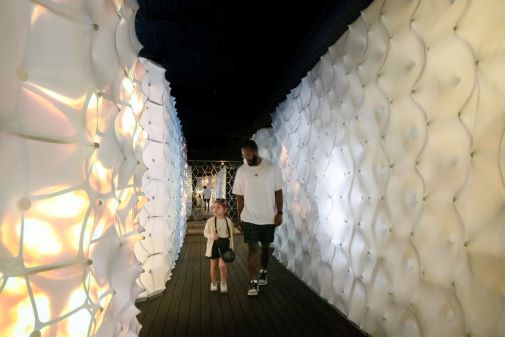A University of York researcher is helping to bring the world of bees to life in a landmark show at the World Museum in Liverpool.
 The exhibition is a fusion of art and science, image by Mark Hadden
The exhibition is a fusion of art and science, image by Mark Hadden
Bees: A Story of Survival is open now and runs until May 2025. The exhibition is a fusion of art and science and showcases the research of Dr Oliver Wilson from the Department of Environment and Geography at the University of York.
Using cutting-edge audio-visual technology, it explores the lives of bees from across the globe. Transporting audiences into their world through a stunning, immersive soundscape featuring 40,000 bees.
Cutting-edge microscopy
A key part of the exhibition is pollen, the powdery substance which is essential for bees' diets, as well as for ecosystem functions across planet Earth. Dr Wilson uses cutting-edge microscopy to produce 3D scans of pollen grains, which were laser-etched into illuminated glass blocks for the exhibition.
Virtual images of the pollen grains also feature in an amazing interactive symphony - accompanied by beautiful music. The artistic reimagining of his research was led by multidisciplinary award-winning visual artist Wolfgang Buttress.
Thinking differently
Dr Wilson said: "This is an amazing exhibition, and I'm delighted to have been able to contribute to it. It is wonderful to see my 3D pollen models being reimagined in this creative and beautiful way. I hope the exhibition encourages people to think differently about the natural world – especially bees, pollen, and all the wonderful and critical microscopic life that we so often overlook.
"I also hope people come away with a renewed passion for protecting our native bees and the wildflowers and natural habitats on which they depend. I'm enormously grateful to Wolfgang Buttress and the World Museum for the opportunity to be involved in this incredible project."
Digital meadows
Visitors embark on a journey through the exhibition, following a path through spaces inspired and shaped by the architecture of the beehive. Audiences can engage with bees through a live stream directly into the heart of a living colony. Using sounds and scents, visitors follow a trail from trees to digital wildflower meadows, highlighting the critical importance of bees as pollinators in the natural world.
Bees: A Story of Survival brings to life what it is like to see and hear like a bee. The exhibition imagines and dramatically highlights the devastating impact of a world without these fascinating and essential creatures.
Earth's sentinels
Artist Wolfgang Buttress explained: "Bees can be seen as sentinels of the earth. They have been around for over 120 million years and are exquisitely tuned to the environment. Their health and wellbeing mirror the health of the Earth and they are dying in unprecedented numbers. Their existential challenges reflect our own – they die and suffer, we die and suffer.
"This exhibition was imagined to be like no other. The intention was to create an emotionally engaging and sensory stimulating experience to express the wonder and diversity of bees. I want the audience to feel empathy as well as an understanding and appreciation of these incredible creatures. If we love and respect bees a little bit more after seeing this exhibition, then we may well make the Earth a better place for them and us to live in."
Multi-sensory experiences
The technology in the exhibition pushes boundaries. Wolfgang Buttress added: "I was keen to make sure that the technology that we have used is non-intrusive, quiet and robust. There is a plethora of cutting-edge equipment involved in this exhibition, including LCD and laser projectors, LED programmable lighting, bone conductors, vibrating plates and scent diffusers, all with the aim of creating a multi-sensory experience for visitors."
An exhibition highlight is Symphony, a space where visitors can be part of a responsive artwork and soundscape. Featuring sounds from over 40,000 bees, movement is captured live in the space and expressed as 'light' shadows resembling stardust or pollen.
Interpreting research
World Museum's extensive entomology collection and specialist curators have played a key role in the development of Bees: A Story of Survival.
With over 30,000 specimens of bees – including the UK's rarest bee, Osmia xanthomelana, found only on a single site in North Wales – the museum's natural history collections are used to support national and international research on the impact of environmental change on plant and animal populations.
Understanding science
Anne Fahy, head of World Museum, said: "An artwork and a science exhibition, Bees: A Story of Survival will push the boundaries of museum interpretation, educating and fascinating through a unique experience, and helping visitors to understand what we all can do to protect these intricate and resilient creatures. We were so happy to include Dr Wilson's 3D models in this, they are a key way for us to help new audiences understand the science behind the power of pollination. Bringing art and science together can be an amazing way to highlight the impact of human behaviour on the Earth and create lasting positive change."
The 3D Pollen Project is spearheaded by Dr Wilson at the University of York. The project aims to scan and print the world's pollen in 3D, and then share the outputs for outreach, education & research. It is funded by the Natural Environment Research Council.
Further information:
Bees: A Story of Survival runs at World Museum, part of National Museums Liverpool, until Saturday 5 May 2025.
The 3D Pollen Project is led by Dr Oliver Wilson at the University of York. The project aims to scan and print the world's pollen in 3D, and then share the outputs for outreach, education & research. It is funded by the Natural Environment Research Council.











